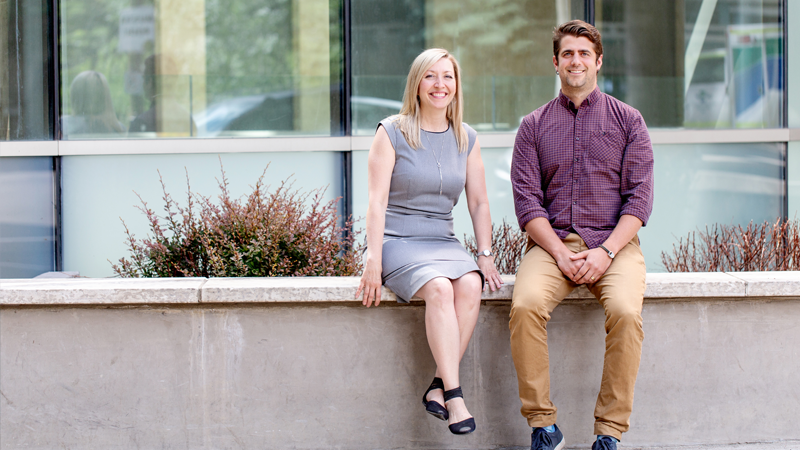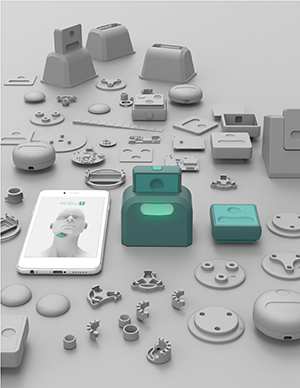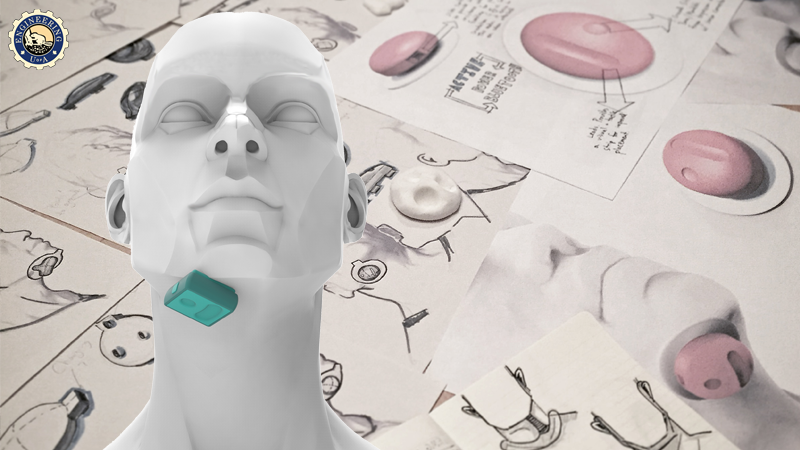
Mechanical 2006 Engineering Grad Dylan Scott with Faculty of Rehabilitation Medicine professor and clinician Jana Rieger.
A new medical device envisioned by a faculty member of the University of Alberta Faculty of Rehab Medicine and developed with the help of a UAlberta Engineering graduate promises to improve the lives of patients with trouble swallowing, a condition known as dysphagia.
Taking the place of expensive, refrigerator-sized machines, the hand-held, wireless Mobili-T device allows patients to receive therapy in their own homes and on their own schedules.
Most of us swallow roughly 50 times per hour-not just when eating, but involuntarily throughout the day, even when sleeping. When we suddenly lose the ability to swallow due to disease or medical treatment, our quality of life drastically declines, and rehabilitation can be a long and tedious road.
It's a journey Kimberly Flowers knows all too well. She was diagnosed with cancer of the tongue in 2014. Although the tumor itself was relatively small, her surgery was extensive and ultimately lead to dysphagia.
"Basically, your whole oral cavity-throat, neck, everything gets worked over," she says. "Muscles get cut. Blood vessels and nerves get severed. Nerves get damaged."
Then came radiation. "You get a sunburn, basically, from inside your esophagus outward. That basically atrophies those muscles. The whole vascular system in that area gets damaged permanently."
Flowers faced a difficult recovery. The treatment left her not only physically challenged, but socially isolated as well. "[Dysphagia] impacted every single aspect of my life," she says. "Meals are the centre of our social life. You go out for meals with friends, and eat every day with family or loved ones."
Three years later, she can eat in restaurants (albeit with a limited diet), but still can't interact as she used to. "Through most of the meal, I have to be very quiet and concentrate on my swallowing. If I don't, I will choke."
 Jana Rieger, a professor and clinician with the Faculty of Rehabilitation Medicine, helped Flowers and others overcome this problem. Typically, a therapist connects patients to an electromyographic device that measures electrical activity in muscles, and then leads them through a series of exercises. "They can essentially watch what their muscles are doing," Rieger explains.
Jana Rieger, a professor and clinician with the Faculty of Rehabilitation Medicine, helped Flowers and others overcome this problem. Typically, a therapist connects patients to an electromyographic device that measures electrical activity in muscles, and then leads them through a series of exercises. "They can essentially watch what their muscles are doing," Rieger explains.
A successful course of therapy can get some patients off their feeding tubes, or help prevent them from choking. But there's one big problem, Rieger says. "Patients weren't coming in for therapy. Intensive therapy means dragging yourself into a hospital daily for six to eight weeks at least. Even for people who live in Edmonton, it was just something they couldn't fit into their daily routine."
The situation is even more dire if you can't easily access a clinic, says Rieger. "When we looked at our patient population, only about 10 per cent of people who needed the therapy were coming in for it."
Rieger and her clinical colleagues put forth a bold idea. "What if we made something that would take the place of this big machine, and the patient could take it home? They would be able to do this therapy at home, every day."
Enter Dylan Scott (Mechanical '06, MASc Dalhousie '10), then a biomechanical engineer at Institute for Reconstructive Sciences in Medicine (IRSM). After he heard about the idea, Scott and his colleague Herman Lundgren started looking into the possibilities. "We saw that this wasn't anything crazy, where you'd need to invent some new technology," Scott recalls. "It was just making things smaller and more adaptable for today's world."
Within a month, Scott and Lundgren had come up with a rough prototype: a sensor roughly the size of a smartphone, hooked up to a laptop. "It didn't work great, but it worked," says Scott. "We were able to get the same signal that the big, expensive machine picked up."
From there, the team secured funding to refine their project. As the engineers kept tweaking the hardware and software, Rieger felt at times like she had her own personal wizards. "Initially it was wired, and I asked, 'why can't we make this wireless?' " And, in seemingly no time at all, Scott and Lundgren showed her the new Bluetooth version.
During development studies, the team researched ways to make it easy for patients to put the device on their chins, with adhesives to help it stay there. Patients also gave their feedback on what they wanted in an app-and what they didn't want.
"I had a really young, vibrant software and research team around me," Rieger says. "They had all these ideas for games-people jumping over things, and running over bridges, and all kinds of fun stuff. We asked patients which of these they liked the best. They said, 'Swallowing is so hard for me, and takes so much of my concentration, that adding a game to it stresses me out. I want something really simple.'"
With the Mobili-T device and app, Rieger believes they finally have a system that will allow patients with dysphagia to complete their therapy at home. "It's like a remote clinician," she says. "The app puts the patient through an exercise program. It tells them how many swallows they have to perform, how many different exercises they have to do, and keeps track of their progress. Every time there's a muscle contraction, this little device senses it and sends a message to the app on the phone. And then that information gets fed back to the clinician."
 Thanks to the Internet, distance is effectively erased. "I could have a patient up in High Level, Alberta, and be able to track their progress," says Rieger. Instead of checking into the clinic every day, patients can check in once a week-by Skype, if they're too distant to visit in person.
Thanks to the Internet, distance is effectively erased. "I could have a patient up in High Level, Alberta, and be able to track their progress," says Rieger. Instead of checking into the clinic every day, patients can check in once a week-by Skype, if they're too distant to visit in person.
During development, Flowers was thrilled to provide input. Even if Mobili-T won't benefit her directly, it will improve the recovery experience of others. "Travel is exhausting when you suffer from fatigue," she says. "Sometimes you can't even dress yourself or shower in the morning. With this device, patients can do their therapy from home. And not when the appointment says they should, but when they have the energy and stamina to do it."
An initial trial is now underway, under the guidance of one of Rieger's PhD students, Gabriela Constantinescu. A Health Canada Investigational Testing Authorization allows the team to conduct pre-commercial testing on real patients.
Patients in the study will use the Mobili-T device at home for six weeks, then return for evaluation. In addition to reassessing patients' swallowing skills, researchers will ask for product feedback, says Rieger. "What works for them? What maybe still needs to be improved? Do they want to keep it?"
Scott, now employed (like Rieger) by the Faculty of Rehabilitation Medicine, is confident patients will indeed want to keep the Mobili-T. "We've been designing for productization and manufacturing right from the get-go," he says. "We want it to be a consumer health product."
Through TEC Edmonton, the team has filed a patent (in Canada, the U.S., and Europe) for the technology. They have formed a company around the product (True Angle Medical Technologies) in order to pursue investors and find a suitable manufacturing partner. Assuming they succeed, they will then apply for a medical device license-a final hurdle that should prove reasonably easy to cross by that point.
In the meantime, Scott says, it's already been a gratifying ride-especially for a former mechanical student like him, who never imagined he'd change lives of people living with such enormous health struggles. "I did nothing related to patients or health," he says. "I didn't expect myself to be in this realm. Now that I am, it's crazy to see the impact that something like this could have."